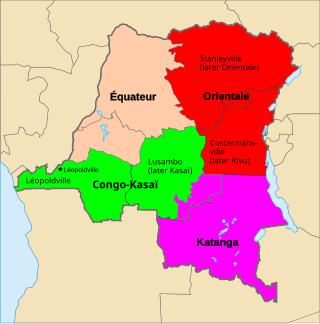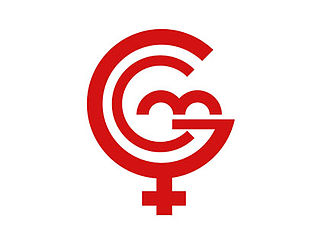
Katanga was one of the four large provinces created in the Belgian Congo in 1914. It was one of the eleven provinces of the Democratic Republic of the Congo between 1966 and 2015, when it was split into the Tanganyika, Haut-Lomami, Lualaba, and Haut-Katanga provinces. Between 1971 and 1997, its official name was Shaba Province.

La Générale des Carrières et des Mines (Gécamines) is a Congolese commodity trading and mining company headquartered in Lubumbashi, in the Katanga region of the Democratic Republic of Congo. It is a state-controlled corporation founded in 1966 and a successor to the Union Minière du Haut-Katanga. Gecamines is engaged in the exploration, research, exploitation and production of mineral deposits including copper and cobalt.

Eurasian Natural Resources Corporation PLC (ENRC) was a public, Kazakhstan/Central African-focused, multinational leading diversified natural resources company headquartered in London, United Kingdom. It had activities in integrated mining, processing, energy, logistics and marketing.

The mining industry of the Democratic Republic of the Congo produces copper, diamonds, tantalum, tin, gold, and more than 70% of global cobalt production. Minerals and petroleum are central to the DRC's economy, making up more than 95% of the value of its exports.
Katanga Mining Ltd was a mining company operating in the Democratic Republic of the Congo with its headquarters in Canada. Katanga Mining operated a major mine complex in the Congo's Katanga Province, producing refined copper and cobalt. It claimed to have the "potential of becoming Africa's largest copper producer and the world's largest cobalt producer."
Copper mining in the Democratic Republic of the Congo mainly takes place in the Copper Belt of the southern Katanga Province of the Democratic Republic of the Congo.
The Kolwezi tailings project also known as the Roan Tailings Reclamation is a project in the Kolwezi mining area of the Democratic Republic of the Congo (DRC) to recover copper from the tailings, or processed ore, from mining in the region since the 1950s. The project was developed by the Canadian mining companies Adastra Minerals and then First Quantum Minerals between 2004 and 2009, when the DRC government revoked First Quantum's license. The project is currently majority owned by the Eurasian Resources Group.
Mutoshi Mine is a copper mine in Katanga Province, Democratic Republic of the Congo. As of 2011 it was 70% owned by Anvil Mining and 30% by the state-owned Gécamines. The mine was placed on care and maintenance in late 2008.
The Etoile Mine is an open-pit copper mine on the outskirts of Lubumbashi in Katanga Province of the Democratic Republic of the Congo (DRC). Chemaf owns the license. Chemaf is 95% owned by Shalina Resources and 5% by the DRC government.
Mashamba East is an open pit copper mine near to Kolwezi in Katanga Province, Democratic Republic of the Congo. As of 2014, the mine was not currently being actively worked.
The Kamoto Mine is an underground copper and cobalt mine to the west of Musonoi in the former Katanga Province, Democratic Republic of the Congo. As of 2022, the site is the largest active cobalt mine in the world. The mine includes the Luilu metallurgical plant, which accepts ore from KOV mine and Mashamba East mine. The plant has polluted the Luilu River, and tailings also pollute the region with wind-blown dust. The Kolwezi Tailings Project is an attempt to recover additional metal from these tailings.

The Luiswishi mine is an open cut copper and cobalt mine in Katanga Province of the Democratic Republic of the Congo (DRC).
Africo Resources was a Canadian mining company whose main property is the copper and cobalt Kalukundi Mine in Katanga Province, Democratic Republic of the Congo. A majority of the company was acquired by Camrose Resources Limited in 2016.

Dan Gertler is an Israeli billionaire businessman in natural resources and the founder and president of the DGI group of companies. Until 2022, his group had mining and oil interests in the Democratic Republic of the Congo (DRC), and has invested in diamonds, iron ore, gold, cobalt, copper, agriculture, and banking. As of 2024 his fortune was estimated at $1.5 billion by Forbes.
Nikanor plc was a publicly quoted holding company for Global Enterprises Corporate (GEC) with assets in the rich Copperbelt region in Katanga Province, Democratic Republic of the Congo (DRC).
The Kananga Mine is an open pit copper mine near Kolwezi in Katanga Province, Democratic Republic of the Congo. It is currently officially inactive.
Sodimico is a state-owned mining company in the Democratic Republic of the Congo (DRC).
The Mutanda Mine is an open-pit copper and cobalt mine in the Lualaba Province of the Democratic Republic of the Congo (DRC). It is the largest cobalt mine in the world. Accidents and spills at the mine have killed workers and polluted nearby rivers and fields. An NGO that has documented impacts of the mine concluded that spills have threatened community members' right to food.

Kamatanda is a region just north of Likasi in the Haut-Katanga Province of the Democratic Republic of the Congo. It gives its name to an open-pit copper mine, a railway junction, an abandoned airport and a residential area of Likasi.
The KOV mine is a large, active open pit copper and cobalt mine near Kolwezi in Lualaba Province in the Democratic Republic of the Congo. The site contains some of the highest grade copper ore of any mine in the world. The mine is also one of the world's largest Cobalt producers.







